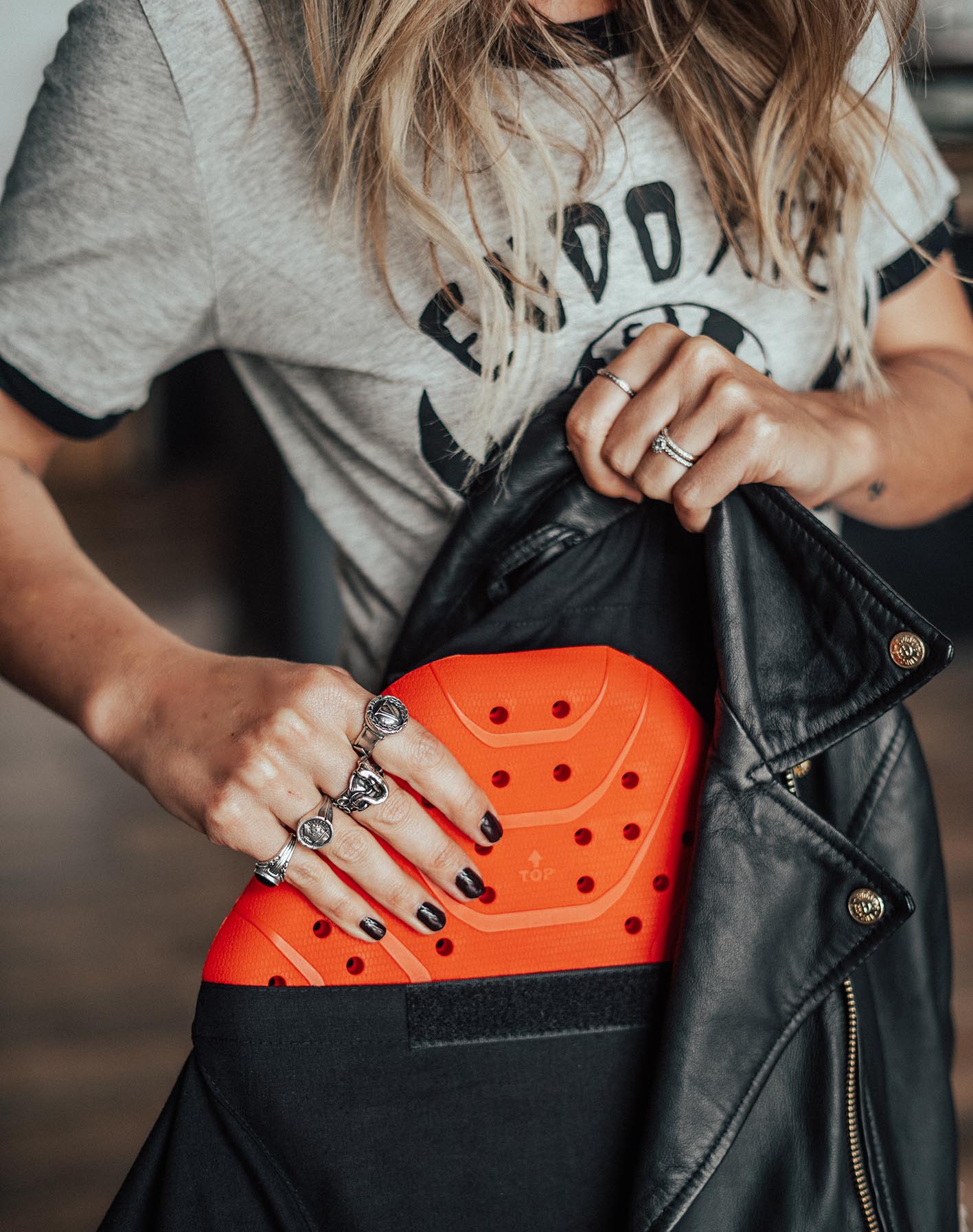Der er hovedsageligt tre typer mennesker, når det kommer til MC-tøj:
- folk, der slet ikke bruger beskyttelsesudstyr (vær venlig ikke at falde i denne kategori 😉)
- dem der bruger et komplet sæt af MC-beskyttelsesudstyr (lad os alle være de mennesker 🙋♀️!)
- folk, der bærer beskyttende MC-udstyr, men tager stødbeskytterne ud 🤷♀️
Selvom sidstnævnte er bedre end den første, er der mange grunde til, at du ikke bør tage stødbeskyttere ud af dine motorcykeljakker, skjorter eller bukser.
Beklædningen i sig selv kan have slidstyrke og kan i tilfælde af en ulykke forhindre dig i at miste din hud, men det er usandsynligt, at det beskytter dig mod alvorlige skader forårsaget af stød. Det er hvad panser eller beskyttere er til. Deres opgave er at reducere den kraft, der vil ramme forskellige dele af din krop i den uheldige situation og på den måde forhindre eller reducere skaden.
I dag er udstyret blevet udviklet så godt, at du ikke nødvendigvis behøver at bære store, stive beskyttere. I stedet har du mulighed for at få tyndere, næsten usynlige beskytter (f.eks. disse TripleFlex beskyttere fra SAS TECH), der vil beskytte dig på vejen.

Så her er de vigtigste ting at vide om stødbeskytterne.
De stødpuder, eller med andre ord - beskytter - der bruges i motorcykeltøjskal være testet efter EN 1621 CE standarden. Forskellige teststandarder gælder for forskellige beskyttere:
EN 1621-1: til skulder (S), albue (E), hofte (H), knæ (K) og underben (L) beskyttere
EN 1621-2: til rygbeskyttere: hel ryg inklusive skulderblade (FB); kun midt bag (CB) og kun lænd (LB)
EN 1621-3: til brystbeskyttere (et stykke eller delt)
EN 1621-4: til mekanisk aktiverede airbagveste
EN 1621-5 for elektronisk aktiverede airbags (denne standard er under udvikling)
Stødbeskyttere har "beskyttelsesklasser" lignede dem til tøjet (kan læse mere om det her), men her kaldes de niveauer..
Derfor, når du handler efter beskyttere, støder du på Level 1 eller Level 2 ratings.
Forskellen mellem de to niveauer er defineret af mængden af kraft, som beskytterne overfører fra et stød. Eller med andre ord - mængden af kraft, som beskytteren kan absorbere til sig selv og dermed minimere påvirkningen af din krop når du rammer ind i noget.
I bund og grund kan CE-Level 2beskyttere simpelthen tage mere kraft, end en Level 1 beskytter kan, og derfor anses de for at være mere sikre.
Hvis du vil blive lidt mere teknisk, er her den maksimale kraft, som beskyttere må overføre (forskellige kraftniveauer gælder for rygbeskyttere og ledbeskyttere (f.eks. skulder, albue, hofte, knæ):
EN 1621-1:2012 (ledbeskyttere):
- Niveau 1: restenergi under 35 kN
- Niveau 2: restenergi under 20 kN
EN 1621-2:2014 (rygbeskyttere):
- Niveau 1: restenergi under 18 kN
- Niveau 2: restenergi under 9 kN
Når du køber beskytterne, vil du også bemærke nogle andre markeringer på dem. Ved siden af indikationen af, hvilket niveau beskytteren er, kan du finde nogle andre vigtige detaljer, såsom:
- T+ og T- markeringer, som indikerer, at beskytterne er testet ved henholdsvis +40°C og -10°C temperaturer. Ikke alle beskyttere bliver temperaturtestet, så det kan være vigtigt, hvis du for eksempel planlægger at bruge dem under bestemte klimaforhold.
- Forskellige bogstaver på beskytteren vil relatere til den påtænkte brug - f.eks. S betyderskulder, E - albue, CB - central ryg osv. Disse kan hjælpe dig med at angive, hvilken slags beskytter det er, hvis du ikke kan genkende det kun fra udseendet.
- 'Type A' eller 'Type B' (på lembeskyttere) identificerer størrelsen af en beskytter, hvor type B er den største. Størrelser på ryg- og brystbeskyttere er baseret på brugerens talje-til-skulder-længde og vil være påført et nummer for størrelsen.
Generelt set bør stødbeskyttere i motorcykeltøj altid have et piktogram af personen på motorcykel - der indikerer, at dette er en stødbeskytter til motorcykeludstyr. Du kan se eksempler nedenfor.


Kropsrustning eller stødbeskyttere skal altid have den rigtige størrelse og passe godt i tøjet. Hvis beskytteren er for lille eller for stor, vil den sandsynligvis give dig ubehag, mens du har den på, men vigtigst af alt vil den ikke yde sit højeste i tilfælde af en ulykke. Prøv aldrig at folde, bøje, rulle eller bue beskyttere, undtagen måske mens du placerer dem i tøjet. Husk også altid at fjerne beskyttere, før du vasker motorcykeltøj, og opbevar dem på et tørt ventileret sted. Du bør aldrig udsætte beskyttere for rengøringsmidler, syre, olie eller andre lignende materialer. Rengør i stedet beskyttere med et tørt håndklæde eller en fugtig klud. Beskyttere er også det produkt, der "slides", derfor anbefales det at skifte beskyttere hvert andet år eller med det samme, hvis der sker skader på det.
Stødbeskyttere spiller en vigtig rolle i motorcykeltøjets sikkerhed, og derfor kan grundlæggende viden om emnet hjælpe dig, når du handler efter mc gear. Jeg håber, at du med denne opsummering vil føle dig mere sikker på, hvad du skal kigge efter næste gang 😉



